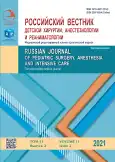Direct inguinal hernias in children
- Authors: Svarich V.G.1,2, Kagantsov I.M.2,3, Svarich V.A.4
-
Affiliations:
- Republican Children’s Clinical Hospital
- Pitirim Sorokin Syktyvkar State University
- V.A. Almazov National Medical Research Center
- Main Bureau of Medical and Social Expertise in the Republic of Komi
- Issue: Vol 11, No 2 (2021)
- Pages: 161-167
- Section: Original Study Articles
- URL: https://journals.rcsi.science/2219-4061/article/view/123173
- DOI: https://doi.org/10.17816/psaic949
- ID: 123173
Cite item
Full Text
Abstract
AIM: Based on the accumulated clinical material, this study aims to show the possibilities of diagnosing and treating direct inguinal hernias in children.
MATERIALS AND METHODS: During the period from 2000 to 2020, 3221 children with inguinal hernias were treated in the surgical department of the Republican Children’s Clinical Hospital in Syktyvkar. Of the above group of children with inguinal hernias, seven patients (0.22%) had direct inguinal hernias. The above was confirmed by ultrasound examination. In laparoscopic imaging, a rectal hernia was defined as a recess of the peritoneum of a stellate or rounded shape in the projection of the medial umbilical fossa. Two patients underwent the Bassini herniation procedure. Two children underwent laparoscopic hernia repair with intracorporeal suture insertion. In three patients, hernia repair was performed using the PRMS method.
RESULTS: Long-term results were followed up from six months to 15 years. Immediate and postoperative complications were noted. No recurrence of hernia was reported.
CONCLUSIONS: When establishing direct inguinal hernia diagnosis in children is clinically determined in the form of a rounded, soft-elastic formation localized medially and above the Pupart ligament next to the projection of the external (superficial) inguinal ring of the inguinal canal. It is easily set into the abdominal cavity with rumbling and confirmed by ultrasound examination results. The most preferred treatment method for direct inguinal hernia in children, in our opinion, is hernia repair using the percutaneous internal ring suturing (PIRS) method.
Keywords
Full Text
##article.viewOnOriginalSite##About the authors
Vyacheslav G. Svarich
Republican Children’s Clinical Hospital; Pitirim Sorokin Syktyvkar State University
Author for correspondence.
Email: svarich61@mail.ru
ORCID iD: 0000-0002-0126-3190
SPIN-code: 7684-9637
Dr. Sci. (Med.)
Russian Federation, Syktyvkar; 116/6 Pushkin str., Syktyvkar, 167004Ilya M. Kagantsov
Pitirim Sorokin Syktyvkar State University; V.A. Almazov National Medical Research Center
Email: ilkagan@rambler.ru
ORCID iD: 0000-0002-3957-1615
SPIN-code: 7936-8722
Dr. Sci. (Med.), main scientific researcher
Russian Federation, Syktyvkar; Saint PetersburgVioletta A. Svarich
Main Bureau of Medical and Social Expertise in the Republic of Komi
Email: svarich61@mail.ru
ORCID iD: 0000-0003-0858-1463
Deputy Chief Expert on Clinical Expert Work
Russian Federation, SyktyvkarReferences
- Clarke S. Pediatric inguinal hernia and hydrocele: An evidencebased review in the era of minimal access surgery. J Laparoendosc Adv Surg Tech. 2010;20(3):305–309. doi: 10.1089/lap.2010.9997
- Spakhi OV, Kopylov EP, Pakholchuk AP. Diagnostics and treatment of inguinal-scrotal hernias in children. Child health. 2016;1(69):152–154. (In Russ.)
- Akramov NR, Omarov TI, Gallyamova AI, Matar AA. Laparoscopic herniorrhaphy evolution in congenital inguinal hernias in children. Pediatric and adolescent reproductive health. 2014;(2):81–93. (In Russ.)
- Solov’ev AE, Laricheva OV, Kulchitsky OA. Sliding inguinal hernias in children. Khirurgiia (Mosk.). 2017;6:51–54. (In Russ.) doi: 10.17116/hirurgia2017651-54
- Jurakulovich KhA, Dzhalilov NA. Features of surgical treatment of inguinal hernias in children (literature review). Young Scientist. 2015;(22):303–308. (In Russ.)
- Kogan MI, Sizonov VV, Makarov AG. Comparison of laparoscopic and open methods of treatment in pathology of the peritoneal vaginal process. Bulletin of Urology. 2016;(3):28–40. (In Russ.) doi: 10.21886/2308-6424-2016-0-3-28-40
- Dvorakevich AO, Pereyaslov AA. Minimally invasive treatment of recurrent inguinal hernias in children. Pediatric surgery. 2016;20:140–143. (In Russ.) DOI: 0.18821/1560-9510-2016-20-3-140-143
- Kozlov YuA, Novozhilov VA, Baradieva PZh, et al. Pinched inguinal hernias in children. Russian Bulletin of Pediatric Surgery Anesthesiology and Resuscitation. 2018;(8):80–95. (In Russ.) doi: 10.30946/2219-4061-2018-8-1-80-95
- Jadhav DL, Manjunath L, Krishnamurthy VG. A study of inguinal hernia in children. IJSR. 2014;3(12):2147–2155.
- Schier F. Direct inguinal hernias in children: laparoscopic aspects. Ped Surg Int. 2000;16:562–564.
- Lapshin VI, Razin MP, Smirnov AV, Baturov MA. Congenital direct inguinal hernia in a child. Pediatric surgery. 2017;21(1):52–53. (In Russ.) doi: 10.18821/1560-9510-2017-21-1-52-53
- Bhullara JS, Martinb M, Dahman B. Direct inguinal hernia containing a prolapsed bladder in an infant. Ann of Ped Surg. 2013;9(4):157–158. doi: 10.1097/01.XPS.0000433916.86929.ac
- Prudnikova EA, Alibegov RA. Inguinal hernias: modern methods of plastic surgery Bulletin of the Smolensk Medical Academy. 2010;4:104–107. (In Russ.)
- Shilo RS, Mogilevets EV, Kondrichina DD, Karpovich VE. Endoscopic total extraperitoneal hernioplasty in inguinal hernia surgery. Journal of the Grodno State Medical University. 2017;(1):110–114. (In Russ.)
- Ivanov YuV, Avdeev AS, Panchenkov DN, et al. The choice of a surgical method for the treatment of inguinal hernia. Bulletin of Experimental and Clinical Surgery. 2019;12(4)274–281. (In Russ.) doi: 10.18499/2070-478X-2019-12-4-274-281
- Blandinsky FV, Nesterov VV, Sokolov SV, et al. Surgical treatment of boys with inguinal canal hernias. Analysis of five-year experience Creative surgery and Oncology. 2019;9(1):37–43. (In Russ.) doi: 10.24060/2076-3093-2019-9-1-37-43
- Kozlov YuA, Novozhilov VA, Krasnov PA. Comparative analysis of 569 cases of laparoscopic and open inguinal hernioraphy in children of the first three months of life. Annals of Surgery. 2013;(5):49–54. (In Russ.)
- Ti AD, Fayzullaev VH, Safroshina EV. Experience of using transcutaneous with laparoscopic-assisted in treating children with inguinal hernias. Terra Medica. 2014;(1)42–44. (In Russ.)
- Ignatiev RO. Surgery of anterior abdominal wall hernias in the practice of a pediatric urologist. Bulletin of Urology. 2015;(1)35–43. (In Russ.) doi: 10.21886/2308-6424-2015-0-1-35-43
- Chinnaswamy Р, Malladi V, Jani KV, et al. Laparoscopic Inguinal Hernia Repair in Children. JSLS. 2005;9(4):393–398.
- Esposito C, Peter SDS, Escolino M, et al. Laparoscopic versus open inguinal hernia repair in pediatric patients: a systematic review. J Laparoendosc Adv Surg Tech A. 2014;11(24):811–818. doi: 10.1089/lap.2014.0194
- Schier F, Klizaite J. Rare inguinal hernia forms in children. Pediatr Surg Int. 2004;20(10):748–752. doi: 10.1007/s00383-004-1291-7
- Ivanov YuV, Avdeev AS, Panchenkov DN, et al. The choice of surgical treatment of inguinal hernia. Bulletin of Experimental and Clinical Surgery. 2019. Т. 4, № 12. С. 274–281. (In Russ.) DOI: 0.18499/2070-478X-2019-12-4-274-281.
Supplementary files
















